

On Mother’s Day, May 9th I had my annual tour of the garden. For the last three years I have opened my garden and invited clients and friends to wander through. The hours of the opening were from 2 p.m. to 5 p.m. and at about 1:45 p.m. the heavens opened up and the rain came down in sheets! What to do? I poured myself a glass of wine (it was Mother’s Day after all) and sat down to watch the rain. As it wound itself down the first guests arrived through the gate. They were from the Perennial Garden Club and they explained that neither rain nor any other bad weather could keep them from touring a garden! They came equipped with umbrellas. As the day wore one, the clouds dispersed and the sun shone bright and beautiful and I lost count of how many people came through.
The garden looked lovely - it had a wonderful watering! A question that I was asked numerous times throughout the day was “how many hours a day/week do you spend maintaining this garden?” I was surprised because I spend very little on maintenance. The garden and the landscape takes care of itself. I have designed plants that grow to certain heights and planted them accordingly. 90% of the plants in the landscape are evergreen. The perennial color comes and goes, and the most amount of effort I spend in the garden is clipping the roses and flowers to bring into the house.
My backyard landscape is nearly four years old and most of the new plants have grown in. I never stuff more plants than can fit into any space so after seasons have come and gone everything has filled in and balances itself with the rest of the shrubs and trees. Many times I have been called upon to redo landscapes that are completely overgrown even though they are not that old. The problem is that often people want the “instant garden” look and they plant too many shrubs that grow too big, and then later on it becomes just another problem! Balance is the key, and balance is about knowing how big a shrub or tree will get - and patience.
I would also like to mention that a client of mine, Sue Anne Sheya plays the flute, teaches flute and offers performances. If you are having a party or function, consider having Sue Anne play! Her phone number is: (530) 746-8783. If I had known about Sue Anne’s flute playing, I would have hired her to play for the garden tour...how lovely to wander through the garden accompanied by sweet flute music!


When all the company left the yard on Sunday, guess who popped out of their home in my wood pile? My four little nursery companions: Sprout, Juniper, Parsley and Violet! Those are the names I’ve given them, but they need to find loving homes, so if you are ready for love and fun, consider one of these little friends. They should be ready for adoption in another two weeks.

















